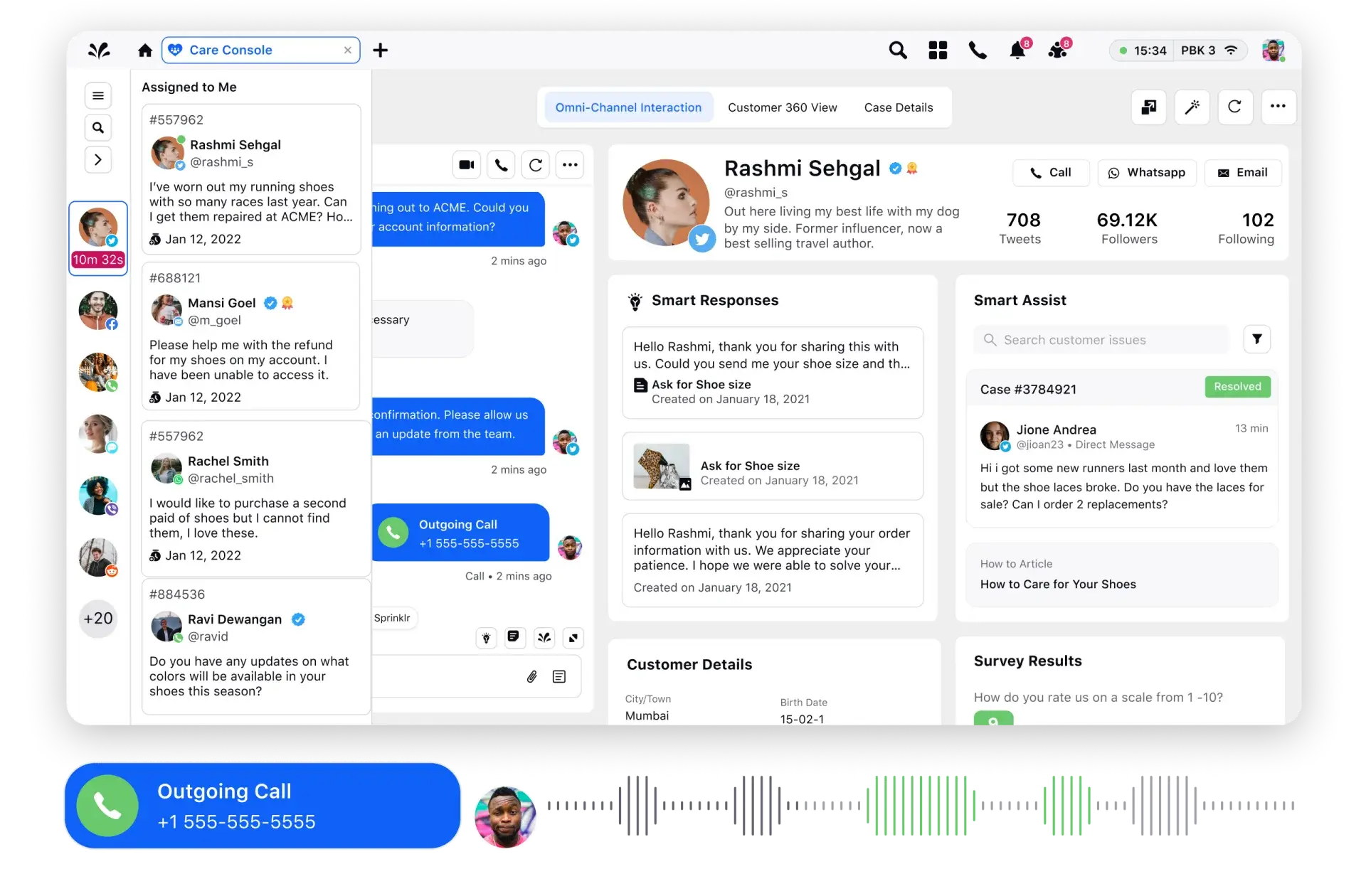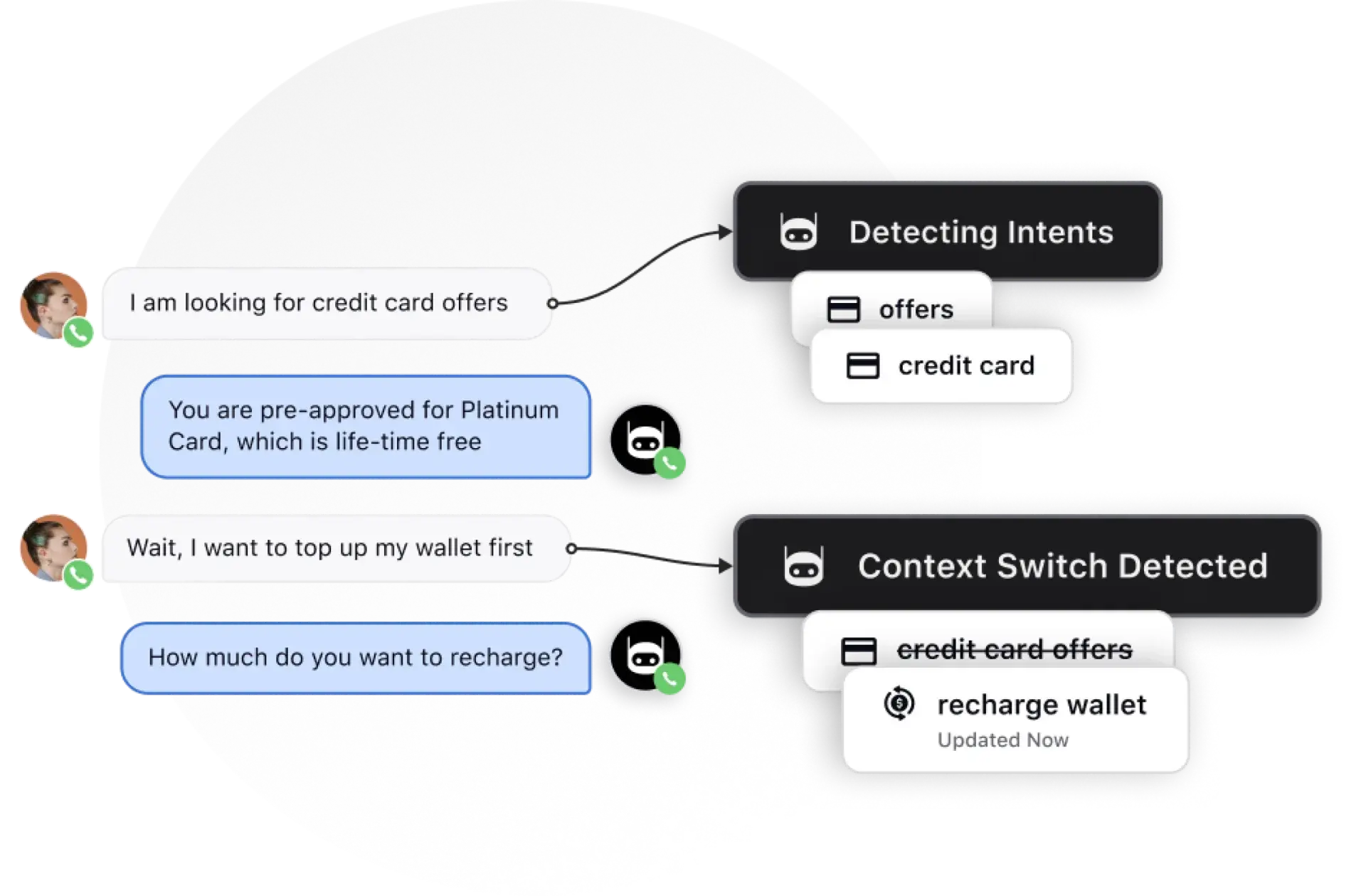What is customer case management
Customer case management systematically handles customer inquiries, complaints and support requests throughout their lifecycle. It helps organize, track and manage customer interactions to ensure timely and satisfactory resolutions.
However, beyond mere issue resolution, customer case management enables you to glean valuable insights into customer preferences, pain points and emerging trends, facilitating informed decision-making and strategic planning.
Effective customer case management necessitates collaboration across various organizational functions and external partners. The key stakeholders in the customer case management process are:
Customer service representatives: Frontline contact center agents tasked with triaging, diagnosing and resolving customer cases while upholding service level agreements (SLAs) and quality standards.
Managers and supervisors: Supervise the performance of customer service teams, identify areas for improvement and implement strategies to enhance efficiency and effectiveness.
IT and technology teams: Responsible for maintaining and optimizing ticketing systems, integrating disparate platforms and leveraging customer service automation to streamline workflows.
Marketing and product development: Use insights from customer cases to refine product offerings, enhance service delivery and craft targeted marketing and advertising campaigns.
Executive leadership: Set the strategic direction to achieve customer service objectives, allocate resources and champion a customer-centric culture across the organization.
Benefits of customer case management
The ticket management landscape has shifted in recent years, propelled by technological advancements and evolving consumer behaviors.
Traditional ticketing systems, characterized by rigid workflows and siloed data, have given way to agile, omnichannel customer service software equipped with robust analytics capabilities, largely absent in the former. This evolution has expedited issue resolution and empowered customer service teams with actionable insights to proactively address emerging issues and anticipate customer needs.
On that note, let's explore the other significant benefits of the customer case management system.
Streamlined support: Consolidating customer inquiries, complaints and requests on a unified platform provides agents with a 360-degree view of each case, facilitating faster and more consistent resolutions. This centralized approach expedites issue resolution and reduces agent workload, leading to a more streamlined support process.
Prompt resolution: Equipped with the necessary tools and information, your agents can efficiently address problems based on urgency and expertise. Access to knowledge bases and collaborative features further accelerates resolutions, ensuring customer issues are resolved promptly and satisfactorily.
Insightful reporting and analytics: Customer case management systems go beyond solving immediate problems; they empower you to improve your entire support ecosystem. Detailed reports on response times, customer satisfaction and other key metrics enable data-driven decision-making. By analyzing trends and tracking team progress, you can make informed adjustments to your customer service workflows, ultimately enhancing overall efficiency and effectiveness.
Seamless social media integration: With the rise of digital customer service, integration with social channels has become essential. Seamlessly incorporating social media platforms allows you to address customer queries and direct messages in real-time, ensuring a consistent and responsive experience across all customer service channels. This integration not only improves customer engagement but also prevents messages from slipping through the cracks, strengthening brand credibility and visibility.
Cross-functional collaboration: Customer case management fosters collaboration across departments, enabling seamless communication and knowledge sharing. Cross-functional teams can collaborate to address complex issues, align solutions and drive continuous improvement.
Compliance and regulatory adherence: Adherence to compliance standards and regulatory requirements is inevitable in regulated industries. Customer case management systems facilitate documentation, audit trails and reporting, ensuring adherence to industry regulations and mitigating legal risks. Maintaining meticulous records and demonstrating compliance can instill trust and confidence in regulatory bodies and customers.
🔍Deep Dive: Contact Center Compliance: Importance, Strategy & Checklist
Top customer case management scenarios
Here are some typical scenarios of the customer case management system in action:
Scenario | Description |
Technical support inquiries | Customers encounter technical issues requiring prompt resolution. Case management ensures triaging, prioritization and assignment to appropriate specialists. |
Product returns and exchanges | Seamless and transparent handling of return requests, tracking and resolution. Streamlined processes minimize administrative overhead and enhance customer experience. |
Billing and payment disputes | Efficient resolution of billing discrepancies and payment disputes to preserve customer relationships and revenue integrity. |
Service outages and incidents | Orchestration of incident response efforts, cross-functional coordination and transparent communication during service disruptions. |
Complex issue resolution | Collaboration across departments to address intricate challenges comprehensively, reinforcing customer trust and loyalty. |
9 tips for smooth customer case management
Quick responses are great, but a strategic approach to customer case management can take your team to the next level. Here are seven actionable tips to ensure your customer support team sails smoothly through any challenge:
Tip #1: Invest in a unified case management system
Switching tabs and juggling screens eat up precious agent time. So, it’s wise to consider investing in a unified case management system that can consolidate customer inquiries, complaints and requests from various contact center channels onto a single platform.
For example, if you run an e-commerce business, you can utilize a contact center CRM system to integrate emails, phone calls and social media messages into a centralized dashboard. With this unified view, your agents can easily track and manage cases, leading to a smooth and hassle-free customer experience.
Good to know: Modern unified agent desktop software consolidates various communication channels onto a single screen, optimizing efficiency and significantly reducing average handle time (AHT) by as much as 30%. Equipping your agents with this tool allows you to seamlessly manage multiple concurrent interactions, providing swift access to comprehensive conversation history and customer details, regardless of the communication channel.

Tip #2 Establish clear case-handling processes
Establish transparent and standardized processes for handling different types of cases. Consider a scenario where a telecom company defines specific workflows for billing disputes, service outages and technical support inquiries. By outlining roles, responsibilities and escalation management, you can empower agents to navigate cases more effectively, reducing resolution times.
💡Pro Tip: Always document successful case resolution strategies and store them in your knowledge base. This repository of best practices can serve as a valuable resource for future reference, enabling agents to learn from each other's experiences and improve their problem-solving skills.
Looking for free knowledge base software?
Here's a helpful read: Must-have Features for Free Knowledge Base Software
Tip #3 Prioritize cases strategically
Develop a customer case prioritization framework to categorize cases based on severity, impact and urgency. For example, in a healthcare setting, critical medical emergencies would take precedence over routine appointment scheduling inquiries. By prioritizing cases effectively, you can ensure timely resolution of high-priority issues and optimize workforce management.
Tip #4 Automate routine tasks
Harness the power of contact center automation and streamline repetitive processes such as ticket creation and email responses. Automating ticket creation based on predefined rules can ensure cases are routed to the right agents, whereas setting up automated email templates for common inquiries saves time and ensures consistent customer communication.
Take, for instance, a banking institution offering an automated customer service chatbot for basic account inquiries and logging a support ticket. Automating repetitive processes can reduce agent workload and enhance overall efficiency.
Tip #5: Prioritize real-time case management
As a business, it's crucial to address customers' needs promptly, even when they prefer to refrain from engaging in live calls. Integrating live chat support into your website and application can be highly beneficial. By doing so, you can provide customers with immediate access to expert assistance without the hassle of navigating IVR or waiting in call queues.
Offering real-time support via live chat improves the customer experience and expedites problem resolution. Customers can receive personalized assistance, ask questions and resolve issues efficiently, all at the convenience of their preferred digital channels.
Moreover, live chat support offers operational advantages and lower costs than traditional toll-free lines. The live chat agents can assist multiple customers simultaneously, maximizing efficiency and reducing wait times for all parties involved.

How Sprinklr AI+ helps:
Sprinklr AI+ takes your customer service to the next level by providing intelligent recommendations to agents tailored to each customer interaction. By seamlessly integrating with voice calls and live chat platforms, Sprinklr AI+ suggests relevant knowledge base articles, similar past cases and the next best actions in real-time. This empowers agents to deliver personalized and effective solutions quickly, reducing the time spent searching for information and typing responses.
Furthermore, Sprinklr AI+ automatically summarizes and closes cases after the conversation ends, allowing agents to transition seamlessly to the next customer in the queue. This automation improves your call center efficiency and ensures consistent and timely case management, ultimately enhancing overall customer satisfaction.

Tip #6: Offer self-service options
According to Gartner, 38% of Gen Z and millennial customers will likely abandon a customer service issue if they can't resolve it independently through self-service channels.
Hence, empowering customers with customer self-service options, such as an organized knowledge base or a FAQ chatbot, is essential for meeting these evolving preferences. You can provide customers with immediate access to answers and solutions, reducing the need for direct assistance from support agents.
With fewer routine inquiries, agents can dedicate more time and attention to addressing complex issues and engaging in high-intent conversations that require personalized assistance.
🌎Good to know: Modern conversational AI platforms are versatile, extending their reach across over 25 channels, including voice and supporting communication in more than 100 languages. Their user-friendly drag-and-drop interface simplifies the entire process—from discovery and building to testing, deployment and KPI measurement. Powered by generative language models, the bots dynamically manage requests and seamlessly resume conversations after interruptions, providing human-like experiences. Learn more about conversational AI.

Tip #7 Foster knowledge sharing and collaboration
Creating a culture of knowledge sharing and collaboration among your support team members can lead to continuous improvement and exceptional service delivery. Encouraging agents to share their insights, success stories and troubleshooting tips during team meetings and brainstorming sessions will help new members learn the best practices.
Moreover, when your team leverages their collective expertise and diverse perspectives, they can solve complex cases more efficiently and identify innovative solutions to common challenges.
Tip #8 Continuous agent training
A contact center is a stressful environment with always room for improvement. By offering regular training to agents on new product features, industry best practices and advanced troubleshooting techniques, you can instill confidence in agents and allow them to handle complex problems easily.
Investing in continuous learning and development can help agents stay current with industry trends and updates. This allows them to address customer inquiries and deliver proactive customer service confidently.
Tip #9: Encourage feedback and continuous improvement
Agents use your customer case management software daily, which makes them the best source of valuable insights. It is important to ask them about their likes and dislikes regarding the software. Their feedback can uncover crucial aspects, such as how well the different tools work together, whether the software feels like a seamless part of their workflow and any other pain points they might encounter.
How to choose a perfect customer case management software
Here are some practical points to consider when choosing the perfect customer case management software for businesses of any size:
Scalability: Scalability is key when selecting customer case management software. Look for solutions that can seamlessly grow alongside your business, accommodating increasing customer inquiries without compromising performance.
Ease of use: Prioritize customer case management software with a user-friendly interface, ensuring that even minimal training can quickly make agents proficient. Intuitive design and streamlined workflows will boost productivity and reduce onboarding time for new team members.
Customization options: There are no one-size-fits-all customer case management solutions. So, seek a solution that allows customization to fit your specific business needs and workflows. The ability to tailor fields, workflows and reporting dashboards ensures that the software aligns with your unique requirements and processes.
Integration capabilities: Select software that seamlessly integrates with your existing tools and systems, such as CRM systems, helpdesk software and communication channels. Integration capabilities are critical in the long run as they facilitate data sharing, streamline contact center workflows and enhance overall efficiency.
Automation and AI features: Look for AI-powered features that can automate routine tasks, such as case routing, prioritization and response generation. These features can increase agent efficiency, improve customer response times and enhance customer experience.
Reporting and analytics: Choose a platform that provides robust reporting and analytics capabilities to track key customer service metrics, monitor agent productivity and gain insights into customer behavior. Comprehensive customer service reports enable data-driven decision-making and continuous improvement.
Security and compliance: Prioritize security and compliance features to protect sensitive customer data and ensure regulatory adherence. Ensure that the customer case management software you’ve shortlisted offers robust data encryption, access controls and compliance with industry standards such as GDPR and PCI DSS.
Customer support and training: Consider the level of customer support and training the software provider offers. Opt for a vendor that provides 24/7 customer support, comprehensive training resources and ongoing assistance to help you maximize the value of your purchase.
Cost-effectiveness: It is critical to evaluate the total cost of ownership, including upfront costs, subscription fees and additional expenses such as customization or integration fees. Also, ask if there are any hidden charges. Choose a solution offering transparent pricing and a strong return on investment.
User feedback and reviews: It is essential to seek input from other users and review platforms to determine user satisfaction and identify any potential issues or limitations of the software. When looking for reviews, pay attention to businesses similar in size and industry to ensure relevance to your needs.
Though almost every business today strives for customer service excellence, only some succeed. Enterprises often grapple with fragmented systems and overwhelmed agents, resulting in dissatisfied customers and missed opportunities.
Enter Sprinklr Service — a game-changing AI-powered solution tailored for performance and scalability. With its AI-native architecture and intelligent case routing capabilities, Sprinklr ensures swift resolutions and satisfied customers. Moreover, its comprehensive reporting delivers invaluable insights for continuous workflow enhancement. Book a demo today and discover how Sprinklr Service can transform your business.
Frequently Asked Questions
related products
Thank you for contacting us.
A Sprinklr representative will be in touch with you shortly.
Contact us today, and we'll create a customized proposal that addresses your unique business needs.
Request a Demo
Welcome Back,
No need to fill out any forms — you're all set.




